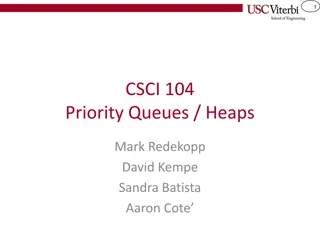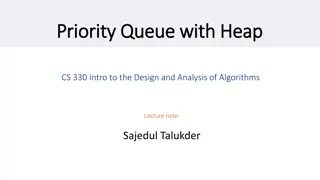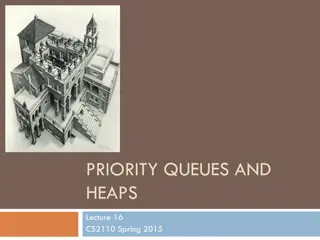Mid-Term Assessment of NSF Progress on Antarctic Research Priorities
A mid-term assessment of the National Science Foundation's progress on the 2015 Strategic Vision for Antarctic and Southern Ocean Research highlights key research priorities. The assessment focuses on the evolution of Antarctic biota, understanding sea level rise, and the origins of the universe. A committee of experts has been assembled to evaluate recent advances and propose strategies to overcome implementation challenges. The report is due in July 2021.
Download Presentation

Please find below an Image/Link to download the presentation.
The content on the website is provided AS IS for your information and personal use only. It may not be sold, licensed, or shared on other websites without obtaining consent from the author.If you encounter any issues during the download, it is possible that the publisher has removed the file from their server.
You are allowed to download the files provided on this website for personal or commercial use, subject to the condition that they are used lawfully. All files are the property of their respective owners.
The content on the website is provided AS IS for your information and personal use only. It may not be sold, licensed, or shared on other websites without obtaining consent from the author.
E N D
Presentation Transcript
Mid-Term Assessment of NSF Progress on the 2015 Strategic Vision for Antarctic and Southern Ocean Research Priority 2 Community Input Session January 8, 2021
Todays Agenda 2:00 p.m. EST Welcome Overview of NASEM study Meeting objectives Oscar Schofield Bill Detrich 2:10 p.m. EST Structured input/discussion Bill Detrich Ken Halanych Alison Murray 3:30 p.m. EST Adjourn
2015 Academies Report NSF should continue to support a core program of broad-based, investigator-driven research. NSF should pursue the following as strategic priorities in Antarctic and Southern Ocean research for the coming decade: I. How fast and by how much will sea level rise? The Changing Antarctic Ice Sheets Initiative II. How do Antarctic biota evolve and adapt to the changing environment? Decoding the genomic and transcriptomic bases of biological adaptation and response across Antarctic organisms and ecosystems. III. How did the universe begin and what are the underlying physical laws that govern its evolution and ultimate fate? A next-generation cosmic microwave background program.
5 years later, NSF asked the Academies to: Assess progress in addressing research goals outlined in the 2015 report Identify significant recent advances in scientific understanding and/or technical capabilities that present important new opportunities for progress in addressing the mission of NSF s Antarctic Sciences Section. For the three priority research topics: Address any current implementation challenges in advancing these research areas. Suggest strategies to overcome these implementation challenges Report due in July 2021.
Committee OSCAR M. E. SCHOFIELD, chair,Rutgers University AMY BARGER, University of Wisconsin, Madison KELLY BRUNT, University of Maryland and NASA Goddard Space Flight Center ROBERT CLAUER, Virginia Tech INDRANI DAS, Columbia University WILLIAM DETRICH, Northeastern University MICHAEL GOOSEFF, University of Colorado, Boulder KENNETH M. HALANYCH, Auburn University MARK HALPERN, University of British Columbia ALISON MURRAY, Desert Research Institute ERIC RIGNOT, University of California, Irvine AMELIA SHEVENELL, University of South Florida HELIO TAKAI, Pratt Institute TERRY WILSON, Ohio State University ERIC WOLFF, University of Cambridge
Strategic Priority II. How do Antarctic biota evolve and adapt to the changing environment? Decoding the genomic and transcriptomic bases of biological adaptation and response across Antarctic organisms and ecosystems. http://www.xconomy.com/wordpress/wp-content/images/2011/01/computingingenomeage.jpg Recent advances in capabilities for decoding genomes and transcriptomes of key species, as well as metagenomes and metatranscriptomes of species assemblages, present new opportunities to advance our understanding of Antarctica s biological diversity, and species adaptive potential to face new environmental challenges. Proposed: stimulate coordinated efforts among: -lab-based genomic analyses (existing samples) -collection of new biological samples -field-based investigations to study hypotheses developed through lab studies Could encompass Antarctic and Southern Ocean life, ranging from marine mammals to ancient DNA, viruses, Bacteria, with focus on organisms/communities important for understanding past and current adaptation.
Meeting Guidelines Input via polls, chat, and discussion Raise Zoom hand to talk (Depending on Zoom Version, located under reactions or in participants panel.) Please keep spoken comments short, don t repeat what has been said Use chat to support comments made by others or to provide more input Additional comments can be provided via a follow-up survey (to be sent after event; can be anonymous) Meeting is being recorded for committee use only
Evaluation of Implementation1a When and how did you first hear about NSF s goal of understanding adaptation in the Antarctic using omics technologies?
Evaluation of Implementation1b Has NSF sufficiently encouraged proposals from PIs using -omics to understand adaptation and evolution?
Evaluation of Implementation--1c Is Priority 2 sufficiently well defined in the dear colleague letter and annual program solicitations to encourage proposals from PIs using omics to understand adaptation and evolution?
Evaluation of Implementation1d What were the opportunities and barriers in the last 5 years to pursuing research in this priority area?
Progress toward Objectives2a What are the key NSF- funded scientific successes in this research priority since 2015?
Opportunities for Improving Progress3a What are the fundamental research questions and tools that NSF should be funding to advance this research priority?
Opportunities for Improving Progress3b Should NSF solicit omics proposals that are discovery- or resource- based in addition to hypothesis-driven to advance the community?
Opportunities for Improving Progress3c Emerging science: Are there significant recent scientific and/or technical advances that present important new opportunities for progress?
Opportunities for Improving Progress3d Funding Model: Would priority 2 advances be best served with a coherent, targeted initiative vs. PI- driven research?
Opportunities for Improving Progress3e Collaboration: What opportunities could be created to bring researchers in this field together to advance the research goals?
Opportunities for Improving Progress3f What are the fundamental impediments that NSF should target to advance this research priority?























